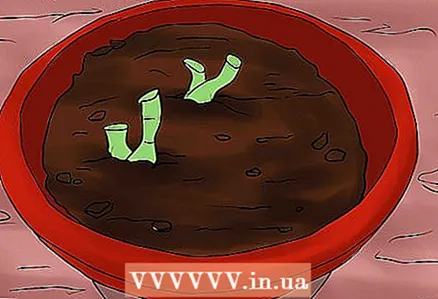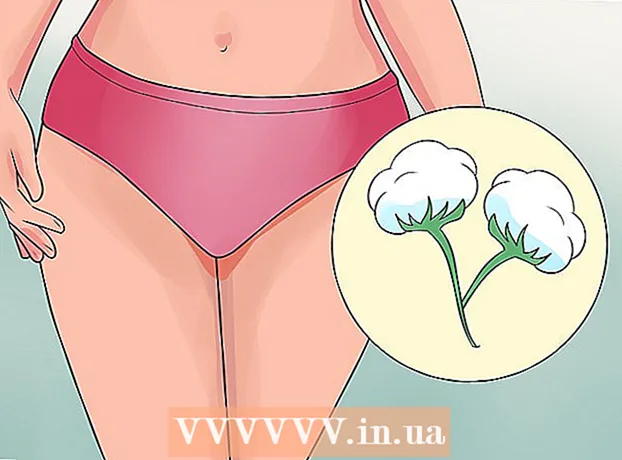Author:
Marcus Baldwin
Date Of Creation:
18 June 2021
Update Date:
1 July 2024

Content
- Steps
- Part 1 of 3: Preparing dahlias for wintering indoors
- Part 2 of 3: Storing dahlias
- Part 3 of 3: Wintering the dahlia outdoors
Dahlias are summer blooming plants with tuberous roots. They are hardy in USDA hardiness zones 7-10, but in colder zones they must be dug up for the winter and stored indoors. If the tubers are left outdoors in colder areas, frost will kill them. This article will show you how to store dahlias indoors and outdoors during the winter. To get started, go to Step 1.
Steps
Part 1 of 3: Preparing dahlias for wintering indoors
 1 Place the dahlias indoors for the winter to keep them free from frost and provide a dormant period. Although dahlias can survive outdoors in American hardiness zones 7-10, in colder zones during the winter they must be moved indoors to keep them warm.
1 Place the dahlias indoors for the winter to keep them free from frost and provide a dormant period. Although dahlias can survive outdoors in American hardiness zones 7-10, in colder zones during the winter they must be moved indoors to keep them warm. - However, many gardeners dig up dahlias for the winter, even in areas where they are hardy, in order to inspect them and provide a dormant period.
- The dormant winter period heals the plant and promotes more lush flowering.
 2 Dig up the dahlias immediately after the first frost. The dahlias should remain in the ground until the first severe frosts kill the leaves and stems and induce a dormant period for the tubers during the winter.
2 Dig up the dahlias immediately after the first frost. The dahlias should remain in the ground until the first severe frosts kill the leaves and stems and induce a dormant period for the tubers during the winter. - Once the foliage has darkened, the aerial portion should be trimmed to a height of about 2 to 6 inches to make it easier to dig up the tubers.

- For digging tubers, it is better to choose a day when there is no rain.
- Once the foliage has darkened, the aerial portion should be trimmed to a height of about 2 to 6 inches to make it easier to dig up the tubers.
 3 Carefully dig up the tubers with a garden pitchfork. Once you are ready to dig up the tubers, stick the pitchfork into the ground about 6 inches from the stem. Do this around the entire plant to loosen the soil. Be careful not to damage the tubers.
3 Carefully dig up the tubers with a garden pitchfork. Once you are ready to dig up the tubers, stick the pitchfork into the ground about 6 inches from the stem. Do this around the entire plant to loosen the soil. Be careful not to damage the tubers. - Stick the forks back into the soil again and pull back on the handle to pull the tubers out of the soil. You can also use a shovel for excavation work, but it is better to do it with a pitchfork.

- Be careful not to damage the outer skin of the tubers. The damaged upper shell makes the tuber unprotected from the penetration of pathogens.

- Stick the forks back into the soil again and pull back on the handle to pull the tubers out of the soil. You can also use a shovel for excavation work, but it is better to do it with a pitchfork.
 4 Trim and peel the dug up tubers. Carefully cut off the dead stems from the tubers and use your hands to scrape off large pieces of soil from the tubers. Rinse off the remaining soil with a hose to reduce the likelihood of fungal infections.
4 Trim and peel the dug up tubers. Carefully cut off the dead stems from the tubers and use your hands to scrape off large pieces of soil from the tubers. Rinse off the remaining soil with a hose to reduce the likelihood of fungal infections. - This can be done by placing them on a fine mesh galvanized steel mesh mounted above a dustbin. Alternatively, simply spread the tubers out on the snack table and rinse with water until the soil is washed off.
 5 Dry the tubers before storing. Spread a layer of newspaper on a flat surface in an area protected from sun and wind. Spread the tubers out on newspaper and let them dry for 24 hours before storing. This will help prevent fungal infection.
5 Dry the tubers before storing. Spread a layer of newspaper on a flat surface in an area protected from sun and wind. Spread the tubers out on newspaper and let them dry for 24 hours before storing. This will help prevent fungal infection. - Alternatively, you can hang the tubers by the stems for one to two weeks in a cool, dry place until they dry out.
Part 2 of 3: Storing dahlias
 1 Cover the tubers with a fungicide before storing. The American Dahlia Society recommends that tubers be immersed in a liquid fungicide such as daconil prior to storage or covered with inexpensive sulfur dust to prevent fungal growth.
1 Cover the tubers with a fungicide before storing. The American Dahlia Society recommends that tubers be immersed in a liquid fungicide such as daconil prior to storage or covered with inexpensive sulfur dust to prevent fungal growth. - The latter method involves mixing about three cups of vermiculite and a teaspoon of sulfur dust in a plastic bag. The tubers are covered with sulfur dust by placing them in a bag and shaking it.
- Gardeners can experiment with this method to find the best balance for themselves.
 2 Pack the dried tubers into a box. Tubers completely dry and treated with fungicide can be stored in a box lined with newspaper, on top of which is a layer of sphagnum moss. Layers of moss and dahlias should alternate until the box is full or until all the dahlias fit.
2 Pack the dried tubers into a box. Tubers completely dry and treated with fungicide can be stored in a box lined with newspaper, on top of which is a layer of sphagnum moss. Layers of moss and dahlias should alternate until the box is full or until all the dahlias fit. - The top layer of tubers should be covered with a final layer of moss, a layer of newspaper is placed on top, then the box is closed.
- Dahlia tubers can also be stored in boxes or crates in a dry environment such as sand, compost, or potting mix.
- If you have tubers of different varieties of dahlias, it is recommended to label the boxes.
 3 Store tubers at 40 to 45 ° F. Maintain this temperature during all stages of storage. At colder temperatures, tubers may die.
3 Store tubers at 40 to 45 ° F. Maintain this temperature during all stages of storage. At colder temperatures, tubers may die.  4 Check the tubers once a month for signs of dryness or disease. If you think the tubers are dry, sprinkle them with water from a spray bottle.
4 Check the tubers once a month for signs of dryness or disease. If you think the tubers are dry, sprinkle them with water from a spray bottle. - If the tubers are very dry, they must be placed in a container with water to revive them.
- If during the next inspection you find diseased or damaged parts of the tubers, they need to be cut off, and then the used garden tools should be disinfected.
 5 If you live in a very cold area, store the tubers in large containers. When living in an area with very cold winters, you can store the dahlia tubers in large containers in which you can store life-size plants.
5 If you live in a very cold area, store the tubers in large containers. When living in an area with very cold winters, you can store the dahlia tubers in large containers in which you can store life-size plants. - In early spring, containers can be placed under a window so that plants can start growing even if the outside temperature is not yet high enough to be placed outside.
 6 Plant overwintered tubers outdoors before the last frost. Do this in the spring, one or two weeks before the last expected heavy frost.
6 Plant overwintered tubers outdoors before the last frost. Do this in the spring, one or two weeks before the last expected heavy frost.
Part 3 of 3: Wintering the dahlia outdoors
 1 Dahlias can hibernate outdoors only in zones 7-10.
1 Dahlias can hibernate outdoors only in zones 7-10.- These zones are highlighted on the USDA hardiness zone map, which divides the United States into zones according to the average annual minimum winter temperature. Each zone is 10 ° warmer (or colder) than the neighboring one.
- You can find out which zone you live in on the website of the National Association of Gardeners by entering your zip code.
 2 Cover the soil with a layer of mulch. Be sure to use a thick layer of mulch if the dahlia tubers overwinter outdoors. The mulch layer should be 5 to 12 inches thick and consist of wood shavings, mushroom compost, grass cuttings, and other organic materials.
2 Cover the soil with a layer of mulch. Be sure to use a thick layer of mulch if the dahlia tubers overwinter outdoors. The mulch layer should be 5 to 12 inches thick and consist of wood shavings, mushroom compost, grass cuttings, and other organic materials.  3 In early spring, remove the mulch and divide the tubers. Do this in March or April. After removing the mulch, the soil will begin to warm up well. Dig up and divide the tubers, then replant them for the best result.
3 In early spring, remove the mulch and divide the tubers. Do this in March or April. After removing the mulch, the soil will begin to warm up well. Dig up and divide the tubers, then replant them for the best result.



